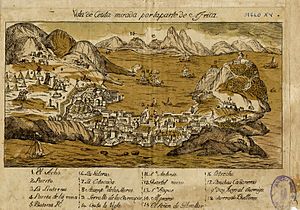Siege of Ceuta (1790–1791) facts for kids
Quick facts for kids Siege of Ceuta |
|||||||
|---|---|---|---|---|---|---|---|
| Part of the Hispano-Moroccan War (1790–1791) | |||||||
 View of Ceuta during the siege. |
|||||||
|
|||||||
| Belligerents | |||||||
| Commanders and leaders | |||||||
| Strength | |||||||
| 12,000 | 18,000 – 20,000 | ||||||
| Casualties and losses | |||||||
| 253 dead | 2,000 dead | ||||||
The Siege of Ceuta (1790–1791) was a big fight between the Kingdom of Spain and the Sultanate of Morocco. It happened during the Spanish-Moroccan War of 1790–1791. This siege, or long attack, on the city of Ceuta was the most important part of the war.
Contents
What Happened During the Siege
On September 25, 1790, the Moroccan army started attacking Ceuta. They used cannons to bombard the city. Their goal was to break through the city walls. If they could make a hole, they planned to rush in.
The Moroccan army set up their main camp in the city's seraglio. They also placed 14 big cannons. But the bombing wasn't constant. This was because Spain and Morocco were also talking about peace.
Spanish Reinforcements
During the siege, Spain sent more soldiers to Ceuta. Most of these new troops arrived in 1791. This happened during a break in the fighting. Spanish ships also helped a lot. They kept communication open between Ceuta and mainland Spain. Special gunboats, invented by Antonio Barceló, were very useful.
Peace Talks and Renewed Fighting
Spanish and Moroccan leaders met many times. These meetings happened between battles. On October 14, 1790, they agreed to stop fighting for a while.
The Moroccan leader, Sultan al-Yazid, wanted to talk about peace in Madrid. The ceasefire lasted from October 1790 until August 15, 1791. Both sides used this time to get more supplies and soldiers.
The Sultan wanted Spain to give up Ceuta. He also wanted some smaller forts. Or, he asked for money instead of fighting. But King Charles IV of Spain said no. He officially declared war again on Morocco. The fighting started once more on August 15, 1791.
Spanish Counter-Attack
The people inside Ceuta noticed something. The Moroccan cannons were not well-guarded when they weren't firing. So, on August 25, the Spanish planned a surprise attack. Soldiers left the city with help from the navy. They caused a lot of damage to the Moroccan cannons.
In response, the Moroccans launched a huge attack on August 30. About 8,000 Moroccan soldiers tried to get into the city. They used their cannons, but they could not break through the walls.
The End of the Siege
On September 14, 1791, the Moroccan leader Sharif Ali asked to talk. He was following orders from the Sultan. The Moroccan soldiers were losing hope. The siege was also costing a lot of money. Plus, the Sultan's brothers were fighting him for the throne.
Because of these problems, the Moroccan troops started to leave. The city was no longer being bombed. However, many of their cannons were left behind. Spain wanted them removed.
The Spanish soldiers left the city twice in September and October. They fought small battles to get the cannons removed. These small fights continued until a peace treaty was signed. The idea of a holy war, or jihad, lost its power to motivate the Moroccan soldiers. The siege finally ended in late 1791.
See also
 In Spanish: Sitio de Ceuta (1790-1791) para niños
In Spanish: Sitio de Ceuta (1790-1791) para niños

